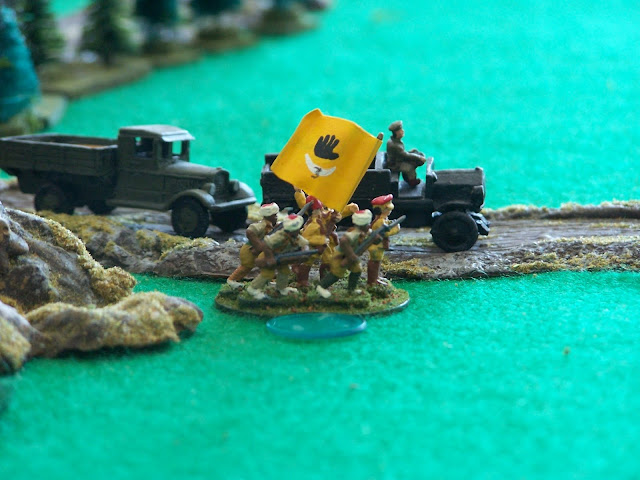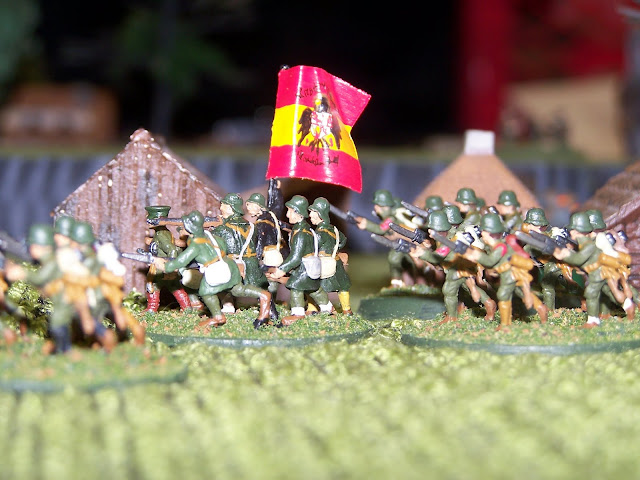On Saturday, the Gaming Group used almost the same table as the week before (used for 1812) to do a French and Indian War raid. (Iron Ivan's 'This Very Ground' rules were used... actually for F&I <Gasp!>)
The British (Andy and Kevin) held the village with two companies of regulars, a company of grenadiers, a company of light infantry, a 6-pounder and crew, and two companies of Provincial infantry, just waking up in their camp. The regulars were on parade or on piquet duty. The French (Robby and I) approached in the morning haze with 3 companies of regulars, a company of grendiers, a company of light infantry, a small company of militia, and 3 small native warbands.[Our cunning plan was to set buildings on fire, disrupt garrison life, cause the British internet service to crash, and steal their wig powder. Well, maybe not the last two.]
 |
| Elmer Borden, chief bull of the herd, looks at the village. I think he's considering buying land. |
The British piquets sounded the alarm and fell back through the woods after exchanging fire with the French lights and militia. The native warbands advanced through the fields on the right as the regulars and grenadiers advanced in line toward the village. The Royal Artillery ran to their gun and began loading. Ithe Hatmen on parade moved to take up a position between building just off the centre square. The grenadiers formed column and advanced toward the French lights, but soon pulled back, realizing that they would be masking the gun. The Provincial companies formed up and began to move to a fence line facing the Natives.
 |
| "Lookit all them white coats, Clem!" The French and Natives advance. |
Two native warbands charged the Provincials behind the rail fence. A mistake as the braves were cut to ribbons. The third warband under the Sachem fired the kitchen house (middle foreground in the photo above.) Two French infantry companies exchanged fire with the British Hatmen. One company fired a volley while the other fired a half-volley (I didn't want to be completely unloaded should the Brits reply in kind.) The two firings took out 30% of the Red-coat company. Nasty! ("Formidable!") Their morale sagged and they fell back. My third French company tried to fire the woods in front of them. Took three activations! (It was more damp than I thought.) Meanwhile, the British grenadiers thought better of things and withdrew to form line in support of the gun and the piquet company. The gun fired on the French lights and achieved great execution... even though they were in loose order. The militia attempted to fire the woods and failed miserably. Since Robby and I set stuff on fire and had cornered the market on wig powder, we made use of the better part of valour and took off. We also upset morning tea. The French grenadiers had the worst of the exchange of fire with the Provincials, who were making a halting attempt to flank the assault force. The Native warbands had been decimated, the lights were hurting, so we withdrew in good order.
 |
| As the Natives get wiped out in the foreground, the second British regular company advances to engage the French grenadiers behind the kitchen house where a native warband engages in pyromania. |
 |
| The fire spreads! Robby loves Andy's fire counters - cotton balls glued to metal washer and given a quick spray with black primer. As a matter of fact, I love them too! |
 |
| Regulars advance, Provincial administer the coup de grace to the native through the rail fence. The Britiah light are in the far background. |
- Fire that volley! A half decent roll will do wonders to your morale as a player and really mess up your opponent's day. Just beware of being caught unloaded.
- Don't use Native warbands a shock troops in open country. In the woods, they're deadly. On the flanks, they'll distract and even scare some opponents. They have great value in drawing people's attention. In the open... eh, not so much.
- Don't mask your cannon. Unless you are NKVD or such, shooting your own troops is a bad idea.
- Don't get distracted by piddly units demonstrating (dancing around) in front of you. Like a red cape to a bull...
- Remember your mission. Keep your eye on the sparrow, as they'd say.
- Don't discount a marginal victory. The second word is the key.
- Always, always, always... have fun. It is why we play with toy soldiers!
































